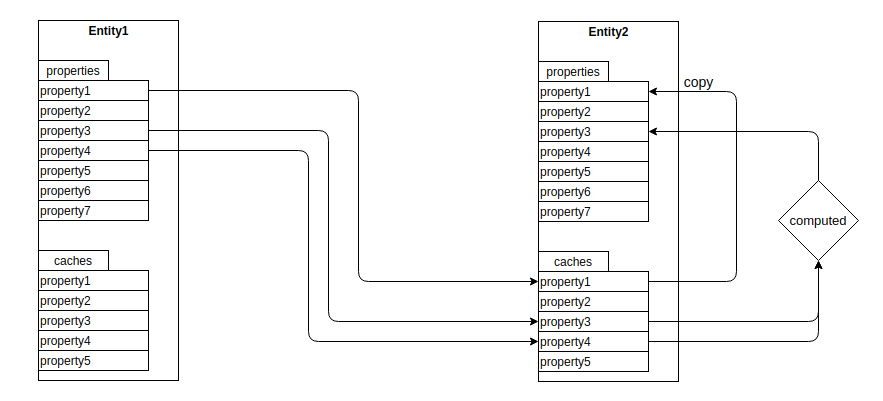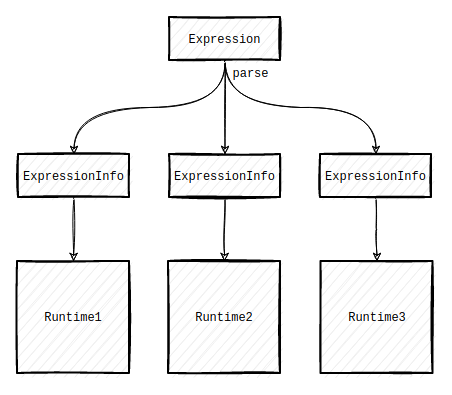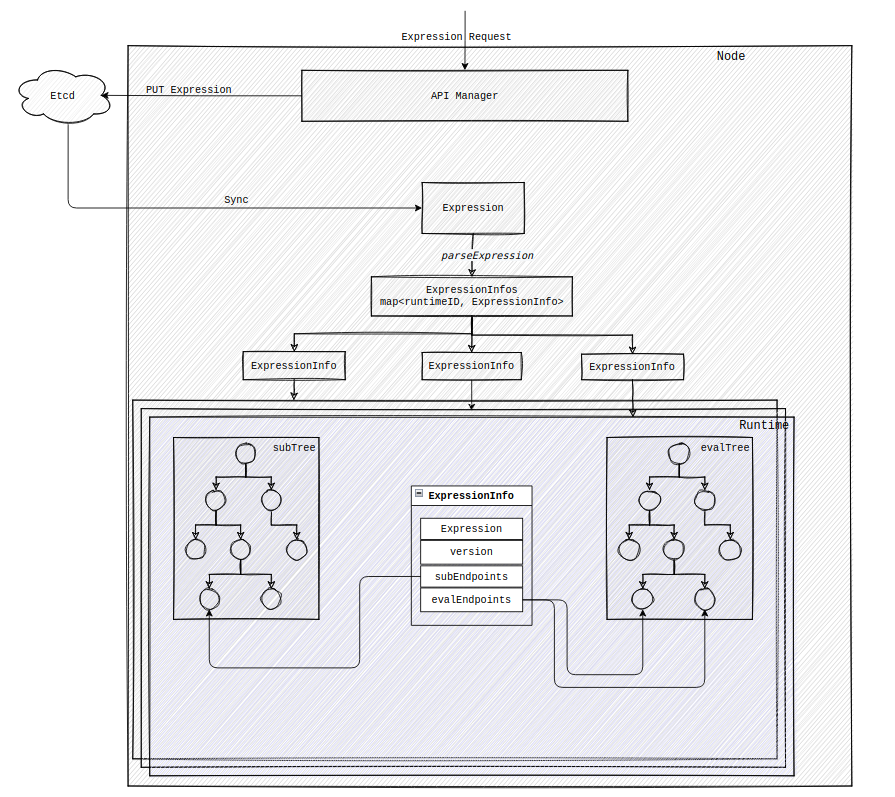映射
映射是指实体与实体之间属性实现计算、重组、赋值的规则。
映射
我们通过配置 Entity1 和 Entity2 之间的映射,实现:
- Entity2.property1 = Entity1.property1
- Entity2.property3 = Entity1.property3 + Entity1.property4

从实体的维度看来,实现映射,也就意味着我们通过映射规则实现了实体之间的通信。
我们通过对此过程的分析,可将这一过程分为三个阶段:
- 传递:实现实体之间数据的传递(写复制)。
- 计算:根据映射规则计算得到输出。
- 更新:使用计算得到的输出结果更新目标实体。
映射规则
我们提供了两类映射规则实现: Expression,TQL。
Expression
表达式,使用简单的语法来对实体属性的赋值方式进行设置:
device123.temp = device234.temp
如存在实体 device123 和 device234, 我们为 device123 配置表达式:device123.temp = device234.temp。次表达式实现使用 device234.temp 属性更新 device123.temp 属性。
使用 core 接口创建此 Expression:
curl --location --request POST 'http://192.168.123.9:32758/v1/entities/device123/expressions?type=DEVICE&owner=admin&source=dm' \
--header 'Content-Type: application/json' \
--data-raw '{
"expressions": [
{
"name": "setTemp",
"path": "temp",
"expression": "device234.temp",
"description": "使用设备实体 device234 的 temp 属性更新设备实体 device123 的 temp 属性。"
}
]
}'
notes: 更多 APIs 详细信息请查看 APIs docs。
表达式资源定义
type Expression struct {
// expression identifier.
ID string
// target path.
Path string
// expression name.
Name string
// expression type, enum{ sub | eval}.
Type string
// expression owner.
Owner string
// entity id.
EntityID string
// expression text.
Expression string
// expression description.
Description string
}
表达式作为一种元数据资源被 core::node 同步并解析处理。
表达式解析
表达式中指定了该表达式计算输入需要的实体ID和实体属性。通过对表达式的解析我们可以得到这些信息,解析结果输出如下:

type ExpressionInfo struct {
// embeded Expression.
dao.Expression
// expression 所属 entity 是否属于当前 runtime.
isHere bool
version int
// subscribe endpoint
subEndpoints []SubEndpoint
// eval endpoint.
evalEndpoints []EvalEndpoint
}
type SubEndpoint struct {
path string
target string
runtimeID string
expressionID string
}
type EvalEndpoint struct {
path string
target string
expresionID string
}
我们解析 Expression 得到多个 ExpressionInfo,然后将 ExpressionInfo 加载到对应的 Runtime 中:
/*
前提:
1. 存在 设备 device234,device345 和 device123
2. 存在两个 runtime
1. device123 和 device234 运行在 runtime1 上
2. device345 运行在 runtime2 上
*/
// expression demo.
{
id: "admin.device123.temp",
name: "sum device temp",
path: "temp",
type: "eval",
owner: "admin",
entity_id: "device123",
expression: "device234.temp + device345.temp",
description: "求和 device234 和 device345 的 temp 属性",
}
// call func parseExpression(expr dao.Expression, version int) (map[string]*ExpressionInfo, error) .
// => result:
{
"runtime1": {
// embed Expression
isHere: true,
version: 1,
subEndpoints: [
{
path: "device234.properties.temp",
target: "device123",
runtimeID: "runtime1",
expressionID: "admin.device123.temp"
}
],
evalEndpoints: [
{
path: "device234.properties.temp",
target: "device123",
expressionID: "admin.device123.temp"
},{
path: "device345.properties.temp",
target: "device123",
expressionID: "admin.device123.temp"
}
]
},
"runtime2": {
// embed Expression
isHere: false,
version: 1,
subEndpoints: [
{
path: "device345.properties.temp",
target: "device123",
runtimeID: "runtime2",
expressionID: "admin.device123.temp"
}
],
evalEndpoints: []
}
}
Expression 在 Runtime 挂载
在 Runtime 模块中我们构建 subTree 和 evalTree 来匹配实体属性更新 path 和映射监听 path,以此完成映射的 传递 和 计算 两个阶段。

ExpressionInfo 中的 subEndpoints 中的端点挂载到 subTree 中,用于在实体状态更新后,配更新实体属性的订阅者,如果存在,则根据 SubEndpoint 将变更属性发送给订阅者;evalEndpoints 中的端点挂载到 Runtime 中的 evalTree,用于订阅者收到订阅消息之后,匹配计算表达式,通过计算表达式计算结果。
Path 匹配原则
当实体的属性变更之后,我们需要知道其订阅者是谁,就需要通过变更属性的path(eg: device234.properties.temp)。
匹配原则:
- 匹配变更path的所有前缀path。
- 匹配所有以变更path为前缀的 path。
- 支持模糊匹配。

匹配变更path的所有前缀path
在 JSON 中,内层字段值发生变更,包含此变更字段的对象也就发生了变更:
{
"a": {
"b": {
"d": 20
},
"c": 800
}
}
// 当 a.b.d 发生变化,那么a, a.b 都包含了变更。
所以当 path: device234.properties.temp 发生变更,下列 path 的订阅者都能收到变更:
- device234.*
- device234.properties
- device234.properties.temp
匹配所有以变更path为前缀的 path
JSON 中外层的字段发生变更,我们判定为其变更字段包含的内层字段同样发生变更:
{
"a": {
"b": {
"d": 20
},
"c": 800
}
}
// 当 a.b 发生变化,那么判定为 a.b.d 也发生了变更。
支持模糊匹配
- Separator:
. - WildcardOne:
+, - WildcardSome:
*,
TQL
TQL 不是一套独立的规则描述,TQL 是一个或多个 Expression 的复合体,且其与 Expression 的使用场景有所区别。
# demo TQL Text.
insert into device123
select
device234.temp as temp,
device234.status as status;
一条 TQL 语句可以转换成多条 Expression,由此我么可以通过 TQL 创建批量创建 Expression。
// TQL => Expressions:
{
id: "admin.device123.temp",
name: "sync device temp",
path: "temp",
type: "eval",
owner: "admin",
entity_id: "device123",
expression: "device234.temp",
}
{
id: "admin.device123.status",
name: "sync device status",
path: "status",
type: "eval",
owner: "admin",
entity_id: "device123",
expression: "device234.status",
}
当然我们更多使用 TQL 用于实体数据的订阅,而非映射,映射可以直接使用 Expression 得到更好的表达。
insert into sub123 select device123.*, device234.properties.temp, device345.*;
Runtime 之间的数据订阅
实体存在于 Runtime 内部,实体之间的通信可以基于Runtime之间的通信来完成,且更加高效。
